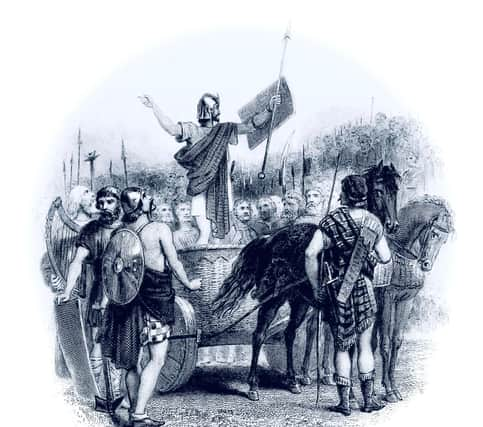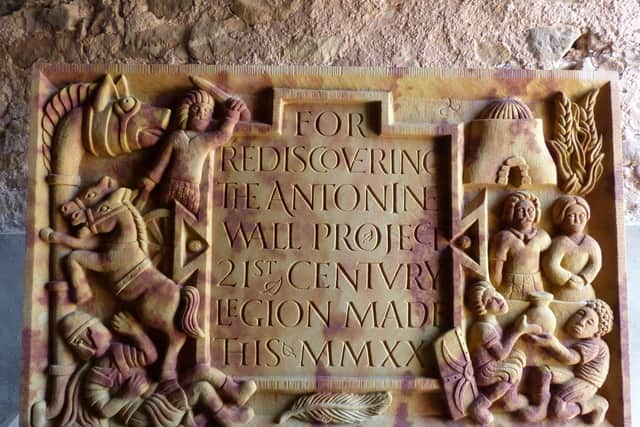Who were the Northern Warriors battling the Romans in Scotland?


But who were the Northern Warriors that clashed with the Roman legionnaires in Scotland, then known as Caledonia, at the end of the 1st Century AD?
Dr Louisa Campbell, archaeology fellow at Glasgow University and consultant on the Resdiscovering the Antonine Wall project, said the Romans met with “dispersed tribal groupings” when they ventured into Caledonia.


Advertisement
Hide AdAdvertisement
Hide AdThe most prominent account of Rome’s campaigns into Northern Britain was written by Publius Cornelius Tacitus, the son-in-law of General Gnaeus Julius Agricola.
Agricola was the commander at the Battle of Mons Graupius, fought somewhere in the north or north-east of Scotland in probably AD83.
There, it is said that between 17,000 and 30,000 Roman soldiers clashed with up to 30,000 men of the Caledonian army, which brought together several Iron Age tribal groups.
Tacitus described the inhabitants of Caledonia as having ‘red hair and large limbs’ who were fierce and quick to fight.
Dr Campbell said the accounts of Tacitus must be treated with caution, not least as it serves as a "propagandist record" taken entirely from a Roman perspective.
However, she added that Tacitus account was also “invaluable” given it provides some details of Agricola’s campaigns and control of the north and south of Britain.
Dr Campbell said: “He refers to the northerners as fierce tribal warrior groups, indeed he appears to respect their prowess in his description.”
Tacitus wrote: “The tribes inhabiting Caledonia flew to arms, and with great preparations, made greater by the rumours which always exaggerate the unknown, themselves advanced to attack our fortresses, and thus challenging a conflict, inspired us with alarm.”
Advertisement
Hide AdAdvertisement
Hide AdLeading up to the battle of Mons Graupius, Tacitus refers to their valour and vigorous character and preparedness for battle when joining of forces to fight the Roman army, Dr Campbell added.
Tacitus also refers to a rousing speech rallying the gathered warriors into battle by Calgacus, who is believed to have been the de-facto leader of the Caledonians.
Dr Campbell said: “Tacitus provides some hints at the physical characteristics of the northerners, describing the Caledonians as having red hair and large limbs.
"His reference to chieftains and various leaders, drawing out Calgacus as the most noble by birth and valour, speaks to some hierarchical structure to these societies, with military experience and bravery marked out as pivotal characteristics of the best leaders.”
Those who fought the Romans in what is now Scotland are depicted in a new Distance Sculpture that will be placed along the line of the Antonine Wall, the most north-westerly frontier of the Roman Empire which was built from around 140 AD and spanned 37 miles between the Firth of Forth and the Firth of Clyde.
Distance Sculptures, or Distance Stones, were used by the Romans to chart their construction efforts as well as display propoganda images that subjugated the local population.
A project by Rediscovering the Antonine Wall, which has been funded by the Heritage Lottery Fund and LEADER to create a new Distance Sculpture, now ‘flips’ the dominant Roman narrative and depicts the Iron Age people who lived alongside and indeed resisted the occupation.
One scene depicts Romans being attacked by fighters in chariots, as was the case at Mons Graupius.
Advertisement
Hide AdAdvertisement
Hide AdDr Campbell added: “This is a thought-provoking piece that speaks to the experiences of the existing occupants of the region who came into conflict with the incoming Roman army.
Like other groups in conflict with the Empire, the northerners are labelled in Roman texts as ‘barbarians’ and they are depicted in the Distance Sculptures as naked, subjugated and ineffective in battle.
“But we need look no further than the material remains to confirm this was not the case as we are left with ample evidence that these were skilled craftspeople who were practicing agricultural economies – they were rearing animals and farming crops.”
“They were building complex structures, such as the broch depicted on the new Distance Sculpture – these are massive circular drystone towers with internal passageways and stairs up to higher levels.
“They were also making pottery and crafting intricate jewellery for personal adornment, including neck torcs, rings, brooches and glass beads. Just like the Scots of today, they were internationalists with contacts across Europe as evidenced by artefacts from different parts of the Empire recovered from Iron Age sites.”
It is said that Mons Graupius was a resounding Roman victory that ended in the death of up to 10,000 Caledonians.
But the true picture of what happened during the encounter will now never be known.
What is clear, however, is that the Caledonians were willing to resist in great numbers with the Romans abandoning their push into Scotland after around 20 years and withdrawing back behind Hadrian’s Wall.”